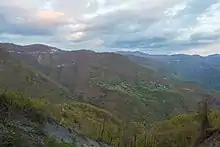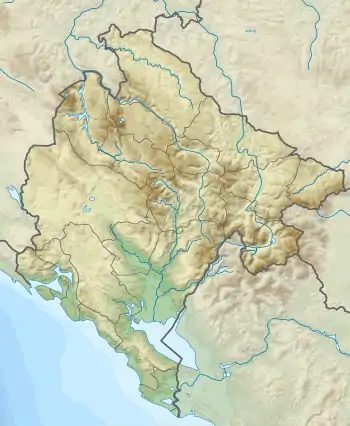Budoš Limestone
The Budoš Limestone ("Budos Mountain Limestone") is a geological formation in Montenegro, dating to 179 million years ago, and covering the middle Toarcian stage of the Jurassic Period. It has been considered an important setting in Balkan paleontology, as it represents a terrestrial setting, with abundant plant material.[3] It is the regional equivalent to the Toarcian units of Spain such as the Turmiel Formation, units like the Wazzant Formation and the Azilal Formation of Morocco and others from the Mediterranean such as the Posidonia Beds of Greece and the Marne di Monte Serrone of Italy.[4][5]
| Budoš Limestone Stratigraphic range: Middle Toarcian ~179 Ma | |
|---|---|
 Duga Valley, where the southernmost Budoš Limestone emerges | |
| Type | Geological formation |
| Thickness | 50–60 m (160–200 ft)[1] |
| Lithology | |
| Primary | Limestones alternated with green marls and calcareous stone |
| Other | Lithified limestone |
| Location | |
| Coordinates | 42°59′30″N 18°54′20″E |
| Region | Nikšić |
| Country | |
| Type section | |
| Named for | Budoš Mountain[2] |
| Named by | Pantić |
| Year defined | 1952[1] |
 Budoš Limestone (Montenegro) | |
Description
Vakhrameev (1991) recovered the abundant macroflora present in the formation, the richest of the Mediterranean Toarcian realm, with several characteristics, such as the abundant presence of thermophilic Bennettitales and Pachypteris, that grew on semi-arid climates.[6] Most of the research of the flora was done by Pantic between 1952 & 1981, recovering abundant Macroflora and Palynomorphs. Several genera where recovered, such as Coniopteris (Dicksoniaceae), Podozamites (Podocarpaceae) and Elatides (Taxodiaceae).[7] It was considered initially that this flora grew in a continental setting, appearing on deposits that resemble modern inland deposition on ferric soils, thus, in a large inland valley with semi-arid conditions but with nearby large water bodies such as lakes.[8] Other opinions suggested that the flora was divided in two groups, a coastal flora and an interior flora, but part of a small island ecosystem similar to modern Bahamas.[9]
In 2019 the Budoš Limestone strata were identified as part of the now lost continent of Greater Adria, as happened with the terrestrial matter on the Marne di Monte Serrone, with the confirmation of a continental origin for the plant matter, as was proposed in 1990.[10]
Fossil content
Megaespores
| Genus | Species | Stratigraphic position | Material | Notes | Images |
|---|---|---|---|---|---|
|
Nannoceratopsis[7] |
|
|
Multiple Spores. |
Affinities with the Dinophyceae. Freshwater Green Algae, related to ponds and static water bodies. |
|
|
Scrinocassis[7] |
|
|
Multiple Spores. |
Dubious Genus with affinities with Dinophyceae. Freshwater Green Algae, related to ponds and static water bodies. |
|
|
Aratrisporites[7] |
|
|
Multiple Spores. |
Affinities with Lycophyta, in situ found related to genera such as Cyclostrobus, Lycostrobus and Annalepis zeiller. |
|
|
Leptolepidites[7] |
|
|
Multiple Spores. |
Affinities with Lycopsida. |
|
|
Styxisporites[7] |
|
|
Multiple Spores. |
Affinities with Lycopsida. |
|
|
Ischiosporites[7] |
|
|
Multiple Spores. |
Affinities with Lycopsida. |
|
|
Calamospora[7] |
|
|
Multiple Spores. |
Affinities with the genus Calamites inside Equisetales. Large spores of Equisetum-like Flora, common near freshwater deposits inland. |
|
|
Densoisporites[7] |
|
|
Multiple Spores. |
Affinities with Selaginellaceae, small flora related to freshwater bodies, specially rivers and ponds. |
|
|
Foveosporites[7] |
|
|
Multiple Spores. |
Affinities with Selaginellaceae, small flora related to freshwater bodies, specially rivers and ponds. |
|
|
Verrucosisporites[7] |
|
|
Multiple Spores. |
Affinities with Pteridophyta. Fern spores related to freswater ponds. |
|
|
Deltoidospora[7] |
|
|
Multiple Spores. |
Affinities with Pteridophyta. Fern spores related to freswater ponds. |
|
|
Granulatisporites[7] |
|
|
Multiple Spores. |
Affinities with Pteridophyta. Fern spores related to freswater ponds. |
|
|
Murospora[7] |
|
|
Multiple Spores. |
Affinities with the genus Pteridophyta. Various kinds of ferns from different environments. |
|
|
Duplexisporites[7] |
|
|
Multiple Spores. |
Affinities with the genus Gleichenia inside Gleicheniaceae. Tropical Ferns related to humid ferric soils. |
|
|
Granulatisporites[7] |
|
|
Multiple Spores. |
Affinities with the genus Gleichenia inside Gleicheniaceae. Tropical Ferns related to humid ferric soils. |
|
|
Monolites[7] |
|
|
Multiple Spores. |
Affinities with the genus Matonia inside Matoniaceae. Ferns of several sizes, from both dry land and near water environments. |
|
|
Matonisporites[7] |
|
|
Multiple Spores. |
Affinities with the genus Matonia inside Matoniaceae. Ferns of several sizes, from both dry land and near water environments. |
|
|
Klukisporites[7] |
|
|
Multiple Spores. |
Affinities with Schizaeaceae. Small ferns spores, abundant on humid locations. |
|
|
Cycadopites[7] |
|
|
Multiple Spores. |
Affinities with the genus Bjuvia inside Cycadales. Spores from Medium-sized Cycas. |
|
|
Bennettiteaepollenites[7] |
|
|
Multiple Spores. |
Affinities with Bennettitales. |
|
|
Obtusisporites[7] |
|
|
Multiple Spores. |
Dubious Genus with affinities with Gymnospermophyta. Named only on this Formation |
|
|
Porcellispora[7] |
|
|
Multiple Spores. |
Dubious Genus with affinities with Gymnospermophyta related to static bodies of water. |
|
|
Skarbysporites[7] |
|
|
Multiple Spores. |
Dubious Genus with affinities with Gymnospermophyta. Named only on this Formation |
|
|
Callialasporites[7] |
|
|
Multiple Spores. |
Affinities with Coniferales. Spores from Arbustive to Arboreal Pine-like trees. |
|
|
Classopollis[7] |
|
|
Multiple Spores. |
Affinities with Cheirolepidiaceae. Spores from Arbustive to Arboreal Coniferous trees. |
|
|
Podocarpidites[7] |
|
|
Multiple Spores. |
Affinities with Podocarpaceae. Spores from Arbustive to Arboreal Coniferous trees. |
|
|
Cerebropollenites[7] |
|
|
Multiple Spores. |
Affinities with Pinaceae. Spores from Arbustive to Arboreal Coniferous trees. |
|
|
Vitreisporites[7] |
|
|
Multiple Spores. |
Affinities with Pinaceae. Spores from Arbustive to Arboreal Coniferous trees. |
|
|
Pityosporites[7] |
|
|
Multiple Spores. |
Affinities with Pinaceae. Spores from Arbustive to Arboreal Coniferous trees. |
|
Plant remains
| Genus | Species | Location | Stratigraphic position | Material | Notes |
|---|---|---|---|---|---|
|
|
Leaves and Branches |
Affinities with Equisetaceae inside Sphenopsida. Near water plants, associated with static freswater ponds and other Humid environments. | ||
|
|
Leaves and Branches |
Affinities with Dicksoniaceae inside Pteridopsida. Tree ferns of Different sizes, associated to humid conditions. | ||
|
|
Leaves and Branches |
Affinities with Umkomasiaceae inside Peltaspermopsida. Large Tree ferns associated to humid conditions. | ||
|
|
Leaves and Branches |
Affinities with Caytoniales inside Peltaspermopsida. Reproductive organ of the Peltaspermales, with berry like cupules with numerous small seeds arrayed along axes. | ||
|
|
Leaves and Branches |
Affinities with Bennettitales inside Cycadeoideopsida. Cycadales-Like medium sized trees. The most abundant flora on the Budos Mountain Limestone. | ||
|
|
Leaves and Branches |
Affinities with Bennettitales inside Cycadeoideopsida. Cycadales-Like medium sized trees. The most abundant flora on the Budos Mountain Limestone. | ||
|
|
Leaves and Branches |
Affinities with Bennettitales inside Cycadeoideopsida. Cycadales-Like medium sized trees. The most abundant flora on the Budos Mountain Limestone. | ||
|
|
Leaves and Branches |
Affinities with Ginkgoales inside Ginkgoopsida. Ginko Relatives with a more wider leaf, representing among the best specimens found on the mediterranean realm. | ||
|
|
Leaves and Branches |
Affinities with Araucariaceae inside Coniferales. Leaves from Arbustive to Arboreal Coniferous trees. | ||
|
|
Leaves and Branches |
Affinities with Araucariaceae inside Coniferales. Leaves from Arbustive to Arboreal Coniferous trees. | ||
|
|
Leaves and Branches |
Affinities with Araucariaceae inside Coniferales. Leaves from Arbustive to Arboreal Coniferous trees. | ||
|
|
Leaves and Branches |
Affinities with Cupressaceae inside Coniferales. Leaves from Arbustive to Arboreal Coniferous trees. | ||
Color key
|
Notes Uncertain or tentative taxa are in small text; |
See also
- List of fossiliferous stratigraphic units in Italy
- Toarcian turnover
- Toarcian formations
- Marne di Monte Serrone, Italy
- Calcare di Sogno, Italy
- Posidonia Shale, Lagerstätte in Germany
- Ciechocinek Formation, Germany and Poland
- Krempachy Marl Formation, Poland & Slovakia
- Lava Formation, Lithuania
- Azilal Group, North Africa
- Whitby Mudstone, England
- Fernie Formation, Alberta and British Columbia
- Poker Chip Shale
- Whiteaves Formation, British Columbia
- Navajo Sandstone, Utah
- Los Molles Formation, Argentina
- Mawson Formation, Antarctica
- Kandreho Formation, Madagascar
- Kota Formation, India
- Cattamarra Coal Measures, Australia
References
- PANTIC, N., 1952: Liassic flora from Budos mountain - Montenegro. - Glasnik Prir. muzeja Srp. zem„ A, 1, 5, 293-308, Beograd.
- Antović, N. M., Svrkota, N., Antović, I., Svrkota, R., Žižić, R., & Živković, D. (2014). Radioactivity impact assessment of Nikšić region in Montenegro. Journal of Radioanalytical and Nuclear Chemistry, 302(2), 831-836.
- PANTIC, N., GRus1c, A. & SLA01c-TR1FuNov1c, M., 1983: The importance of Mesozoic floras and faunas from intraoceanic carbonate platforms for the interpretation of paleogeographic and geodynamic events in the Tethys. - Boll. Soc. Pal. ltaliana 22: 5-14.
- Farinacci, A. (2002). Western Tethys Jurassic Gaps as Windows on the Land: Interaction Between Hot-spots and Gaps (No. 4). Università La Sapienza.
- Dragičević, I., & Velić, I. (2002). The northeastern margin of the Adriatic Carbonate Platform. Geologia Croatica, 55(2), 185-232.
- Vakhrameev, V. A. (1991). Jurassic and Cretaceous floras and climates of the Earth. Cambridge University Press.
- Pantić, N. K. (1981). Macroflora and palynomorphs from Lower jurassic of Budos Mountain, Montenegro. Ann. Geol. Peninsule Balk, 45, 157-171.
- PANTIC, N. & Duuc, 1., 1990: Palaeophytogeography of Jurassic land flores in Tethyan regions and its margins. - Geol. an. Balk. pol., Llll: 237-247, Beograd.
- Barrón, E., Ureta, S., Goy, A., & Lassaletta, L. (2010). Palynology of the Toarcian–Aalenian Global Boundary Stratotype Section and Point (GSSP) at Fuentelsaz (Lower–Middle Jurassic, Iberian Range, Spain). Review of Palaeobotany and Palynology, 162(1), 11-28.
- Van Hinsbergen, Douwe J.J.; Trond H. Torsvik; Stefan M. Schmid; Liviu C. Maţenco; Marco Maffione; Reinoud L.M. Vissers; Derya Gürera, and Wim Spakman. 2019. Orogenic architecture of the Mediterranean region and kinematic reconstruction of its tectonic evolution since the Triassic. Gondwana Research 81. 79–229. Accessed 2020-03-17. doi:10.1016/j.gr.2019.07.009